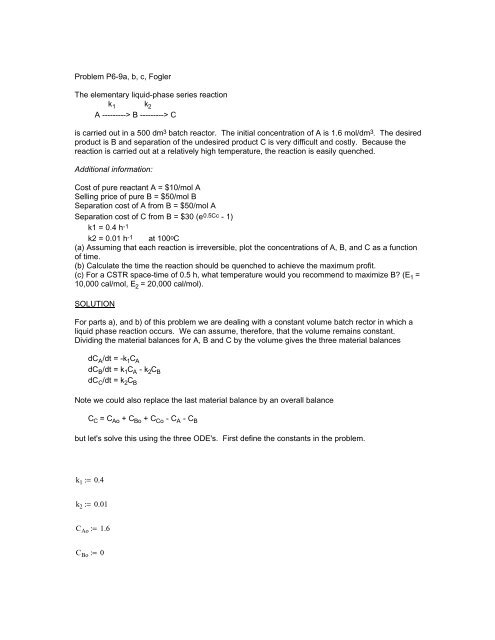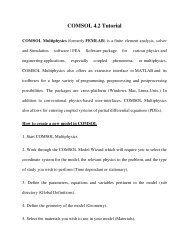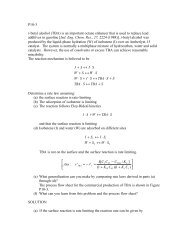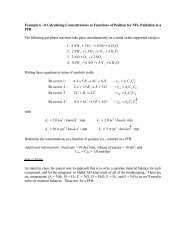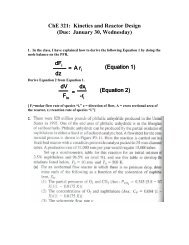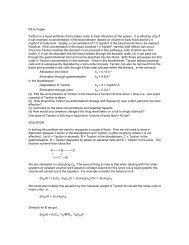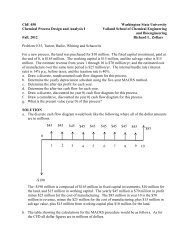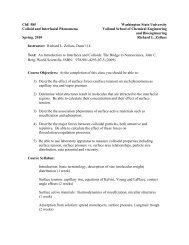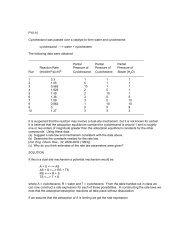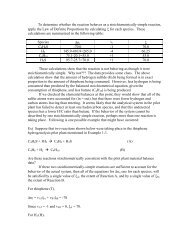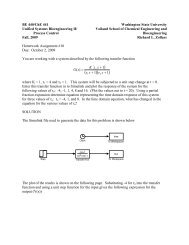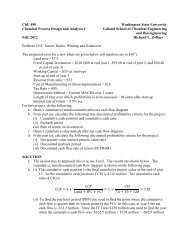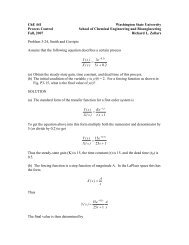Problem P6-9a, b, c, Fogler The elementary liquid-phase series ...
Problem P6-9a, b, c, Fogler The elementary liquid-phase series ...
Problem P6-9a, b, c, Fogler The elementary liquid-phase series ...
You also want an ePaper? Increase the reach of your titles
YUMPU automatically turns print PDFs into web optimized ePapers that Google loves.
<strong>Problem</strong> <strong>P6</strong>-<strong>9a</strong>, b, c, <strong>Fogler</strong><br />
<strong>The</strong> <strong>elementary</strong> <strong>liquid</strong>-<strong>phase</strong> <strong>series</strong> reaction<br />
k 1 k 2<br />
A ---------> B ---------> C<br />
is carried out in a 500 dm 3 batch reactor. <strong>The</strong> initial concentration of A is 1.6 mol/dm 3 . <strong>The</strong> desired<br />
product is B and separation of the undesired product C is very difficult and costly. Because the<br />
reaction is carried out at a relatively high temperature, the reaction is easily quenched.<br />
Additional information:<br />
Cost of pure reactant A = $10/mol A<br />
Selling price of pure B = $50/mol B<br />
Separation cost of A from B = $50/mol A<br />
Separation cost of C from B = $30 (e 0.5Cc - 1)<br />
k1 = 0.4 h -1<br />
k2 = 0.01 h -1 at 100 o C<br />
(a) Assuming that each reaction is irreversible, plot the concentrations of A, B, and C as a function<br />
of time.<br />
(b) Calculate the time the reaction should be quenched to achieve the maximum profit.<br />
(c) For a CSTR space-time of 0.5 h, what temperature would you recommend to maximize B? (E 1 =<br />
10,000 cal/mol, E 2 = 20,000 cal/mol).<br />
SOLUTION<br />
For parts a), and b) of this problem we are dealing with a constant volume batch rector in which a<br />
<strong>liquid</strong> <strong>phase</strong> reaction occurs. We can assume, therefore, that the volume remains constant.<br />
Dividing the material balances for A, B and C by the volume gives the three material balances<br />
dC A /dt = -k 1 C A<br />
dC B /dt = k 1 C A - k 2 C B<br />
dC C /dt = k 2 C B<br />
Note we could also replace the last material balance by an overall balance<br />
C C = C Ao + C Bo + C Co - C A - C B<br />
but let's solve this using the three ODE's. First define the constants in the problem.<br />
k 1 := 0.4<br />
k 2 := 0.01<br />
C Ao := 1.6<br />
C Bo := 0
C Co := 0<br />
V := 500<br />
y :=<br />
⎛<br />
⎜<br />
⎜<br />
⎜<br />
⎝<br />
C Ao<br />
C Bo<br />
C Co<br />
⎞<br />
⎟<br />
⎟<br />
⎟<br />
⎠<br />
D( t,<br />
y)<br />
:=<br />
⎛<br />
⎜<br />
⎜<br />
⎜<br />
⎝<br />
−k 1 ⋅y 0<br />
k 1 ⋅y 0 − k 2 ⋅y 1<br />
k 2 ⋅y 1<br />
⎞<br />
⎟<br />
⎟<br />
⎟<br />
⎠<br />
Z := Rkadapt( y, 0, 200, 200,<br />
D)<br />
ii := 0..<br />
200<br />
2<br />
Concentration Profile<br />
1.5<br />
Concentration (mol/dm^3)<br />
1<br />
0.5<br />
0<br />
0 50 100 150 200<br />
Time (hours)<br />
CA<br />
CB<br />
CC
) For part (b) we need to compute the profit that would be generated. Since we have all of the<br />
concentrations as a function of time we can use this information to compute the profit. <strong>The</strong> profit<br />
would be given by<br />
P = - C Ao<br />
*V*$10 + C B<br />
*V*$50 + C A<br />
*V*$10 - C A<br />
*V*$50 - $30*(e 0.5*CC - 1)<br />
where the first, fourth and fifth terms are negatives because these are costs of the operation. <strong>The</strong><br />
second term is positive as this represents the creation of the product B. <strong>The</strong> third term represents a<br />
credit to process from the recovery of unused A. <strong>The</strong> profit is thus given by<br />
Z ( ii,<br />
4)<br />
:= −10<br />
⋅<br />
C Ao<br />
⋅⎡⎣ ⎡⎣ ( ) ⎤⎦ − 1⎤⎦<br />
⋅V<br />
+ 50⋅Z ( ii,<br />
2)<br />
⋅V<br />
+ 10⋅Z ( ii,<br />
1)<br />
⋅V<br />
− 50⋅Z ( ii,<br />
1)<br />
⋅V<br />
− 30 exp 0.5⋅Z ii,<br />
3<br />
Now plot the profit as shown below<br />
4 . 10 4 Profit from Batch Process<br />
2 . 10 4<br />
Profit ($)<br />
2 . 10 4 0<br />
4 . 10 4<br />
0 50 100 150 200<br />
Reaction Time (hours)<br />
To the nearest hour the maximum in the profit occurs at t = 11 hours with a profit of $27,850.<br />
Part c) We now need to solve this problem for a CSTR and determine an optimum temperature.<br />
<strong>The</strong> first thing to do is to express the two rate constants as functions of temperature. First compute<br />
the preexponential factor.<br />
k 1<br />
A 1 :=<br />
−10000<br />
exp⎛<br />
⎜<br />
1.987⋅373<br />
⎝<br />
k 2<br />
A 2 :=<br />
−20000<br />
exp⎛<br />
⎜<br />
1.987⋅373<br />
⎝<br />
⎞<br />
⎟<br />
⎠<br />
⎞<br />
⎟<br />
⎠<br />
A 1 = 2.896 × 10 5<br />
A 2 = 5.242 × 10 9
<strong>The</strong> material balance for A in a CSTR is given by<br />
0 = F Ain - F Aout + r A V = vC Ain - vC Aout - k 1 C Aout V<br />
but since we are assuming constant volumes (<strong>liquid</strong> <strong>phase</strong> reaction) this can be rearranged to give<br />
or<br />
0 = C Ain<br />
- C Aout<br />
- k 1<br />
C Aout τ<br />
C Aout<br />
= C Ain<br />
/(1 + k 1 τ)<br />
Similarly the material balance for B gives<br />
0 = C Bin<br />
- C Bout<br />
+ k 1<br />
C Aout τ − k 2<br />
C Bout τ<br />
Since C Bin = 0 and we have already solved the material balance to get C Aout the material balance for<br />
B can be expressed as<br />
0 = -C Bout<br />
+ k 1 τC Ain<br />
/(1 + k 1 τ) - k 2<br />
C Bout τ<br />
Solve this equation for C Bout to get<br />
k 1 τC Ain<br />
/(1 + k 1 τ)<br />
C Bout<br />
= _______________<br />
(1 + k 2 τ)<br />
Our problem now is to find where C Bout is a maximum as a function of temperature. We could do<br />
this by plotting the expression above as a function of temperature and visually seeing where the<br />
maximum occurs.<br />
τ := 0.5<br />
T ii := 300 + ii<br />
k 1 ( T) := A 1 ⋅exp<br />
k 2 ( T) := A 2 ⋅exp<br />
C Bout ( T)<br />
:=<br />
⎛<br />
⎜<br />
⎝<br />
⎛<br />
⎜<br />
⎝<br />
−10000<br />
1.987⋅T<br />
−20000<br />
1.987⋅T<br />
k 1 ( T) ⋅τ⋅C Ao<br />
( 1+<br />
k 1 ( T) ⋅τ)<br />
1 + k 2 ( T) ⋅τ<br />
⎞<br />
⎟<br />
⎠<br />
⎞<br />
⎟<br />
⎠
0.8<br />
CB Dependence on Reactor Temperature<br />
0.6<br />
CB (mol/dm^3)<br />
0.4<br />
0.2<br />
0<br />
300 350 400 450 500<br />
Temperature (K)<br />
Thus the maximum in C Bout occurs at a temperature between 436 and 437 K. <strong>The</strong> maximum value<br />
for C Bout is 0.75 mol/dm 3 . Another way to approach this problem is to find the maximum in C Bout by<br />
differentiating the expression for C Bout with respect to T and setting the differential to zero. <strong>The</strong><br />
differentiation and root finding for this problem is going to require quite a bit of algebra. Since this<br />
would also introduce a high probability of error let's use the abilities of MathCAD to do this for us.<br />
<strong>The</strong> first thing we want to do is to use the symbolic manipulator to perform the differentiation. To<br />
keep the expression for the derivative relatively shorter we do not want it to calculate numerical<br />
values (since it will display these as numbers with 16 decimal figures). So use a symbol to<br />
represent E/R for each rate constant.<br />
E1R :=<br />
E2R :=<br />
−10000<br />
1.987<br />
−20000<br />
1.987<br />
Now write just the right hand side of the expression for C Bout (or highlight just the right had side of<br />
the expression above , copy it and past the copy below<br />
⎛<br />
A 1 exp⎜<br />
E1R ⎞<br />
⋅ ⎟⋅τ⋅C Ao<br />
⎝ T ⎠<br />
⎛<br />
⎜1+<br />
A 1 ⋅exp⎛<br />
⎜<br />
E1R ⎞<br />
⎟⋅τ⎞<br />
⎟<br />
⎝ ⎝ T ⎠ ⎠<br />
1 + A 2 ⋅exp⎛<br />
⎜<br />
E2R ⎞<br />
⎟⋅τ<br />
T<br />
⎝<br />
⎠
To perform the differentiation first place the cursor on one of the "T's" in the expression above.<br />
<strong>The</strong>n go to the menu bar at the top of the screen and click on "Symbolics". In the menu that<br />
appears click on "Variable" and on the subsequent menu click on "Differentiate". <strong>The</strong> derivative<br />
of the expression with respect to T will appear below. As the expression below appeared<br />
originally it spread over three pages. I have edited this expression by inserting a line break just<br />
before some of the "+" signs. To do this I put the cursor just before the "+" sign, hit the space<br />
bar until the entire previous term was selected then pressed CTRL+ENTER.<br />
⎡<br />
⎢<br />
⎢<br />
⎣<br />
⎛<br />
⎝<br />
⎞<br />
⎟<br />
⎠<br />
C Ao<br />
⎤<br />
⎞⋅ ⎛ ⎥<br />
⎛ ⎞<br />
⎜⎝ ⎟⋅τ⎞ ⎤ ⎟⎠ ⎥ ⎥<br />
⎠ ⎦ ⎦<br />
E1R<br />
−A 1 ⋅ ⋅exp⎜<br />
E1R ⋅τ⋅<br />
T 2 T ⎛1 A 1 exp⎛<br />
⎜<br />
E1R ⎞<br />
⎜ + ⋅<br />
⎝ T ⎟⎠ ⋅τ⎟<br />
⎝<br />
⎠ 1 A 2 exp⎜<br />
E2R<br />
...<br />
⎡<br />
⎢<br />
+ ⋅<br />
⎣<br />
⎝ T<br />
⎡<br />
2<br />
2 E1R<br />
A 1 ⋅ exp<br />
⎛ ⎞<br />
⎜ ⎟ τ 2<br />
C ⎢⎢⎢⎣<br />
Ao<br />
E1R⎤ +<br />
⋅ ⋅<br />
⋅ ⎥⎥⎥⎦ ...<br />
⎝ T ⎠ ⎡ ⎛ 1 + A 1 ⋅exp⎛<br />
⎜<br />
E1R ⎞<br />
⎜⎝ ⎟⋅τ<br />
⎞ 2<br />
⎢⎣<br />
⎟⎠ ⋅⎛1 + A 2 ⋅exp⎛<br />
⎜<br />
E2R ⎞<br />
⎜<br />
⎝ T ⎠<br />
⎝ T ⎟⎠ ⋅τ⎞<br />
⎤ T 2<br />
⎟ ⎥⎦<br />
⎝<br />
⎠<br />
A 1 ⋅ exp⎛<br />
⎜<br />
E1R ⎞<br />
⎟⋅<br />
⎝ T ⎠<br />
τ 2<br />
C Ao<br />
E2R<br />
+<br />
⋅ ⋅A 2 ⋅ ⋅exp⎛<br />
⎜<br />
E2R<br />
⎡<br />
⎢⎛1 + A 1 ⋅exp⎛<br />
⎜<br />
E1R ⎞<br />
⎜<br />
⎝ T ⎟⎠ ⋅τ⎞<br />
⎟<br />
⎛ ⎝<br />
⎠ 1 + A 2⋅exp⎛<br />
⎜<br />
E2R ⎞<br />
⎜⎝ ⎟⋅τ<br />
⎞ 2 ⎤ T<br />
⋅<br />
⎟⎠ ⎥<br />
2 ⎝ T<br />
⎣<br />
⎝ T ⎠ ⎦<br />
⎞<br />
⎟<br />
⎠<br />
With this derivative we are now ready to use the root finder in MathCAD. Start by giving an initial<br />
estimate - Note that we must use T as the variable since T appears in the expression of the<br />
derivative. <strong>The</strong>n type "Given" to start the root finder.<br />
T := 400<br />
Given<br />
We now need to take a copy of the derivative that was determined above, place it below the "Given"<br />
command and then set it equal to zero using the Boolean equal sign.<br />
⎡<br />
⎢<br />
⎢<br />
⎣<br />
⎛<br />
⎝<br />
⎞<br />
⎟<br />
⎠<br />
C Ao<br />
⎤<br />
⎞⋅ ⎛ ⎥<br />
⎛ ⎞<br />
⎜⎝ ⎟⋅τ⎞ ⎤ ⎟⎠ ⎥ ⎥<br />
⎠ ⎦ ⎦<br />
E1R<br />
−A 1 ⋅ ⋅exp⎜<br />
E1R ⋅τ⋅<br />
T 2 T ⎛1 A 1 exp⎛<br />
⎜<br />
E1R ⎞<br />
⎜ + ⋅ ⎟⎠ ⋅τ⎟<br />
⎝ ⎝ T ⎠ 1 A 2 exp⎜<br />
E2R<br />
...<br />
⎡<br />
⎢<br />
+ ⋅<br />
⎣<br />
⎝ T<br />
⎡<br />
2<br />
2 E1R<br />
A 1 ⋅ exp<br />
⎛ ⎞<br />
⎜ ⎟ τ 2<br />
C ⎢⎢⎢⎣<br />
Ao<br />
E1R⎤ +<br />
⋅ ⋅<br />
⋅ ⎥⎥⎥⎦ ...<br />
⎝ T ⎠ ⎡ ⎛ 1 + A 1 ⋅exp⎛<br />
⎜<br />
E1R ⎞<br />
⎜⎝ ⎟⋅τ<br />
⎞ 2<br />
⎢⎣<br />
⎟⎠ ⋅⎛1 + A 2 ⋅exp⎛<br />
⎜<br />
E2R ⎞<br />
⎜<br />
⎝ T ⎠<br />
⎝ T ⎟⎠ ⋅τ⎞<br />
⎤ T 2<br />
⎟ ⎥⎦<br />
⎝<br />
⎠<br />
A 1 ⋅ exp⎛<br />
⎜<br />
E1R ⎞<br />
⎟⋅<br />
⎝ T ⎠<br />
τ 2<br />
C Ao<br />
E2R<br />
+<br />
⋅ ⋅A 2 ⋅ ⋅exp⎛<br />
⎡<br />
⎢⎛1 + A 1 ⋅exp⎛<br />
⎜<br />
E1R ⎞<br />
⎜<br />
⎝ T ⎟⎠ ⋅τ⎞<br />
⎟<br />
⎛ ⎝<br />
⎠ 1 + A 2⋅exp⎛<br />
⎜<br />
E2R ⎞<br />
⎜⎝ ⎟⋅τ<br />
⎞ ⎜<br />
E2R<br />
2 ⎤ T<br />
⋅<br />
⎟⎠ ⎥<br />
2 ⎝ T<br />
⎣<br />
⎝ T ⎠ ⎦<br />
Now find the root by using the "find" command.<br />
⎞<br />
⎟<br />
⎠<br />
= 0
T opt<br />
:=<br />
Find( T)<br />
T opt = 436.848<br />
C Bout ( T opt ) = 0.75
aterial balance for


